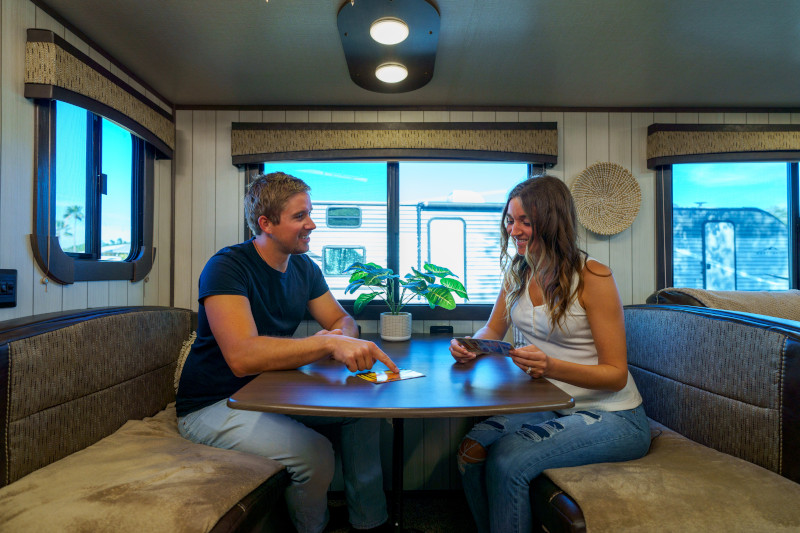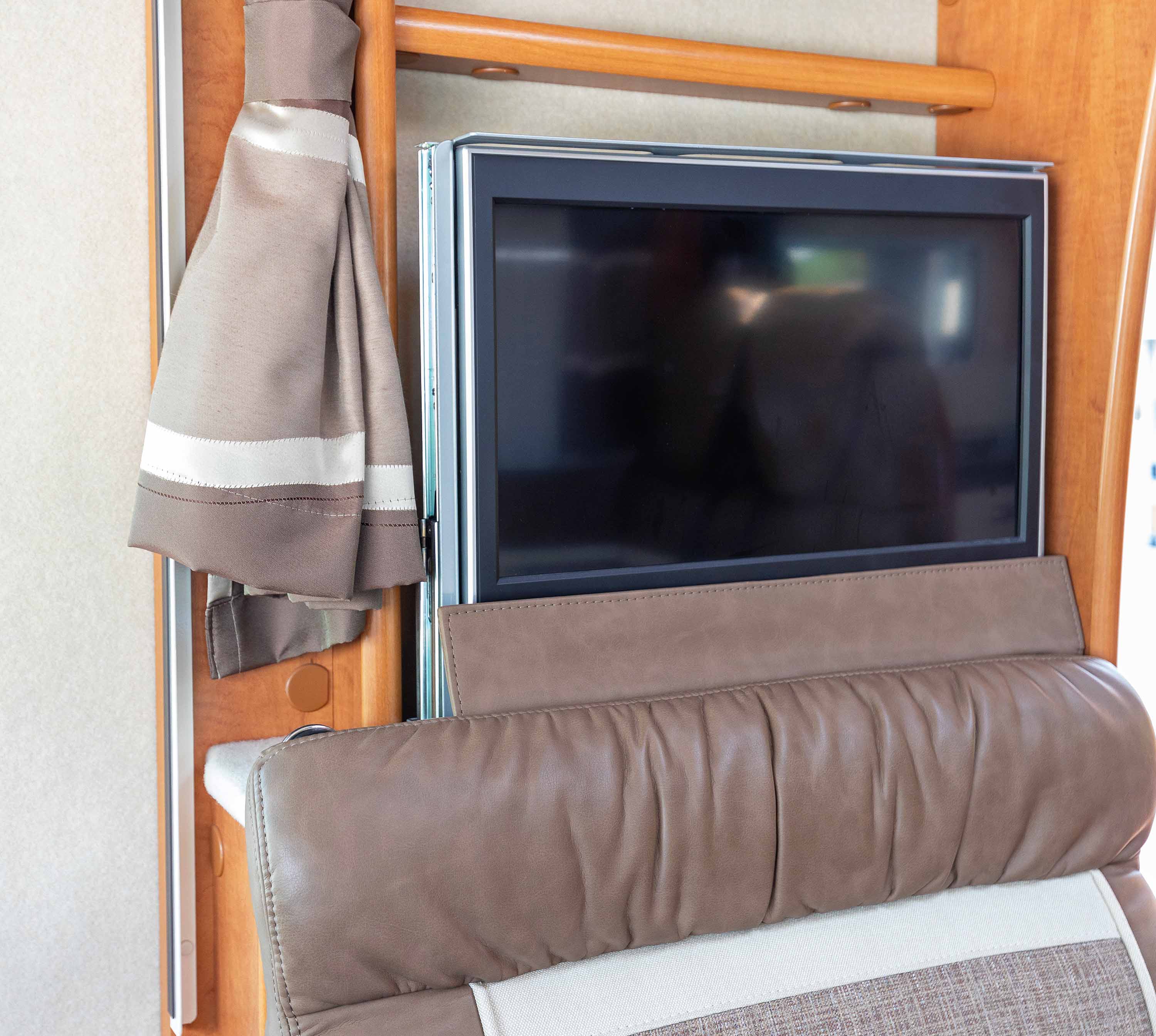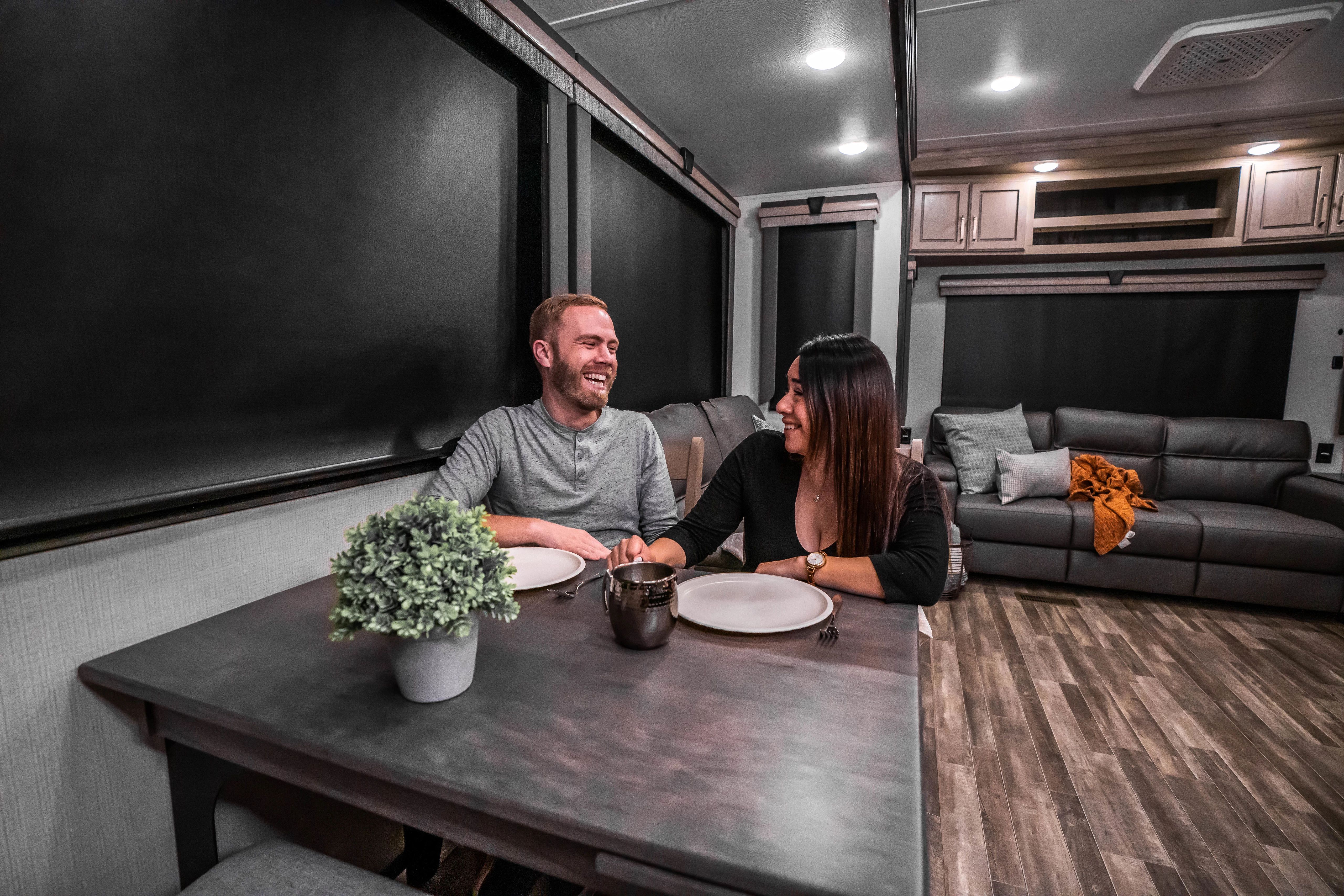WEnRV travel news, products, and industry trends
Embrace Your Space: Choosing The Right Floorplan For Your RV
Whether you’re in the market for a tiny trailer or a sprawling motorhome, shopping for a recreation vehicle involves a lot of choices. One of the main considerations is the selection of a floorplan that accommodates the owner’s requirements and preferences. In many cases, it may be necessary to change to another model, or perhaps a different make, to obtain the desired interior design. But regardless, a suitable floorplan is a key ingredient to the shopping process.
Slides are an integral part of the floorplan if the chosen unit is so equipped. These space expanders actually provide two floorplans: One for in-camp accommodation and living space and the other for stops that do not lend themselves to the deployment of slides.
So let’s first look at the in-camp configuration with all slides in the extended position. This is what is shown in the brochure.
Dinette Type

Photo: Sean Varney
The most common RV dining configurations have a fixed-booth or wall-connected table setup. Some comprise a free-standing table with separate chairs. While the fixed location type is the most popular, the free-standing arrangement has some advantages. First, it can be moved slightly out from the wall providing more elbow room. Larger people may find this more comfortable.
Dining Area Location
The dining table or booth location is more often found on the driver’s side. This is primarily due to the curbside entrance on motorhomes and trailers taking up wall space on the passenger’s side. The position for the dining area on the passenger’s side provides a view of your patio area as opposed to the opposite side view of your lefthand neighbor’s patio. Selecting the passenger side located dining area may offer more privacy and a better view. Additionally, this position can take advantage of the patio awning for sun shielding or increased privacy.

Getty Images
Televator Equipped TV Feature
Though pretty fancy, floorplans that include a televator (motorized TV lift and retraction) have a trade-off when it comes to floorplans. Instead of taking little wall or tabletop space, the televator takes up lower-level space. If mounted behind a sofa, which is common, it requires about eight inches of space behind the couch. This, in turn, requires the couch to be moved out by that amount. For example, a 50-inch TV would use up about 3 square feet of available floor space.

Photo: Mindy Stafford
Bath-and-a-Half
For many, two heads are better than one. Indeed, a second bathroom can be a blessing for a family of four or more. This is a great floorplan option. However, the extra washroom comes with some shortcomings. It takes up space that must come from somewhere. The living room may be somewhat shorter than those without this feature. The bedroom also may be slightly shorter in length. You may find that storage space was also reduced in some manner. But, if chosen wisely, it can be a great optional floorplan.
Interior Livability With Slides Retracted
When you see trailers and motorhomes that are equipped with slides in a showroom or lot, the slides are always extended. Likewise, every brochure illustrating the floorplan is featured with the slides expanded. Nothing wrong with that, but you need to see the vehicle in travel mode, with all slides retracted. You may, on occasion, need to sleep overnight in your RV due to weather, road closure or like while traveling. Deployment of slides in some parking lots or rest stops can be impossible due to traffic, local rules or other safety reasons. So check your ability to access the bed, the washroom, galley, refrigerator and dining seating in the travel mode. In addition, when stopping for lunch or a break at a rest stop, often the extending of slides is not practical or safe. But you’ll still want the ability to reach all the items you need without fuss.
Here’s one way to partially confirm the possibility of having adequate access to the needed spaces within a selected RV using the chosen model’s floorplan diagram:
Floorplan of a Coleman Rubicon trailer. Photo courtesy of Camping World
• Make two copies of the prospective RV floorplan. Observe the floorplan in the camp mode.
• Carefully cut the entire slide sections out of the second copy. Then place or glue the slides into the retracted position with each piece flush with the outside of the body.
Observing this should help you determine the accessibility of needed areas within the coach. If you spot a possible issue, you should physically inspect it. During a tour of the RV, ask a salesman to retract the slides. This will help you determine if access is a problem.
Note: Camping World gives shoppers a Search by Floorplan option. These are just a few things that you might want to check out when selecting a travel trailer, fifth-wheel, or a Class B, C, or A motorhome.
So, now it’s time to get on the open road and enjoy the RV adventures that await.
Peter Mercer — RV Floorplan Thoughts
The post Embrace Your Space: Choosing The Right Floorplan For Your RV appeared first on Good Sam Camping Blog.
Copyright
© Good Sam Camping Blog


